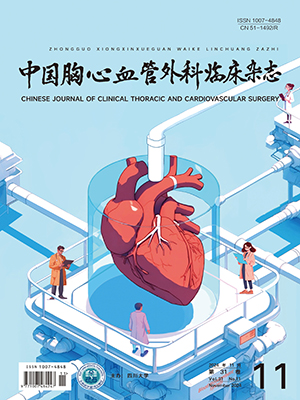Abstract: Objective To observe the physical characteristics of decellularized porcine pulmonary valved conduits crosslinked by carbodiimide (EDC). Methods [WTBZ]Twenty porcine pulmonary valved arteries were mobilized on relative asepsis condition. They were cut longitudinally into three samples at the junction position of pulmonary valve (every sample was comprised of a part of the pulmonary conduit wall and the corresponding valve). The samples were randomly divided into three groups by lotdrawing method. Group A was the control group which was made up of the fresh porcine arterial valved conduit samples without any other treatments. Group B was comprised of porcine pulmonary samples decellularized by trypsindetergent digestion. Group Cincluded the decellularized porcine pulmonary samples crosslinked by EDC. We observed the water content, thickness, tensile strength, and shrinkage temperature of all the samples, based on which the physical characeteristics of these samples were analyzed. Results [WTBZ]Complete cellfree-pulmonary conduit matrix was achieved by trypsindetergent digestion. Compared with group A, in group B, the water content of pulmonary wall was significantly higher (P=0.000), while the water content of pulmonary valve was not significantly different; the thickness of pulmonary wall and valve (P=0.000,0.000) and tensile strength of pulmonary wall and valve (P lt;0.01) was significantly lower, while shrinkage temperature was not significantly different. Compared with group B, in group C, the water content of pulmonary wall was significantly lower (P=0.000), while the water content of pulmonary valve, and the thickness of pulmonary wall and valve were not significantly different; the tensile strength of pulmonary wall (P lt;0.01) and valve (P=0.000), and the shrinkage temperature of them (P=0.000, 0.000) were significantly higher. Compared with group A, in group C, the water content of pulmonary wall and valve, and the tensile strength of them were not statistically different, while the thickness of pulmonary wall and valve was significantly lower (P=0.000, 0.000), and the shrinkage temperature of them was significantly higher (P=0.000, 0.000). Conclusion [WTBZ]EDC crosslinking method is available for treating decellularized porcine pulmonary valved conduits in order to enhance its tensile strength, and decrease water content of pulmonary wall.
Citation: GUO Haiping,LI Wenbin,WANG Sheng,et al .. Study on the Physical Characteristics of Decellularized Porcine Pulmonary Valved Conduits Crosslinked by Carbodiimide. Chinese Journal of Clinical Thoracic and Cardiovascular Surgery, 2011, 18(5): 447-452. doi: Copy




